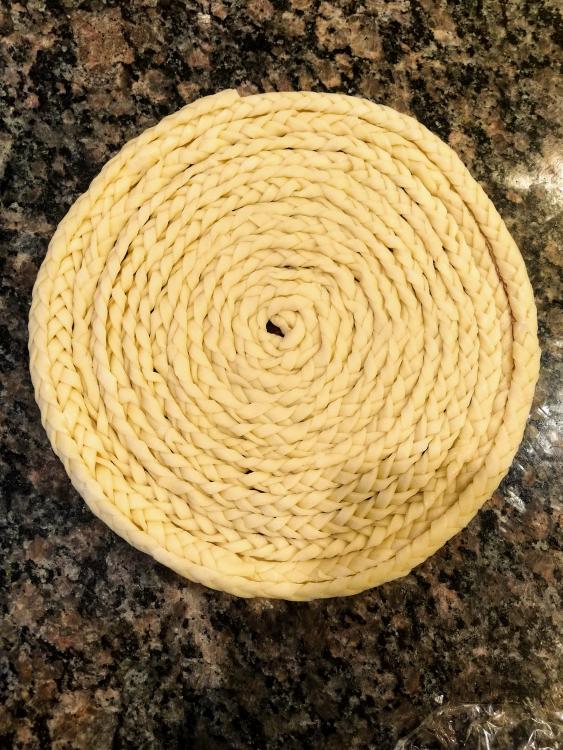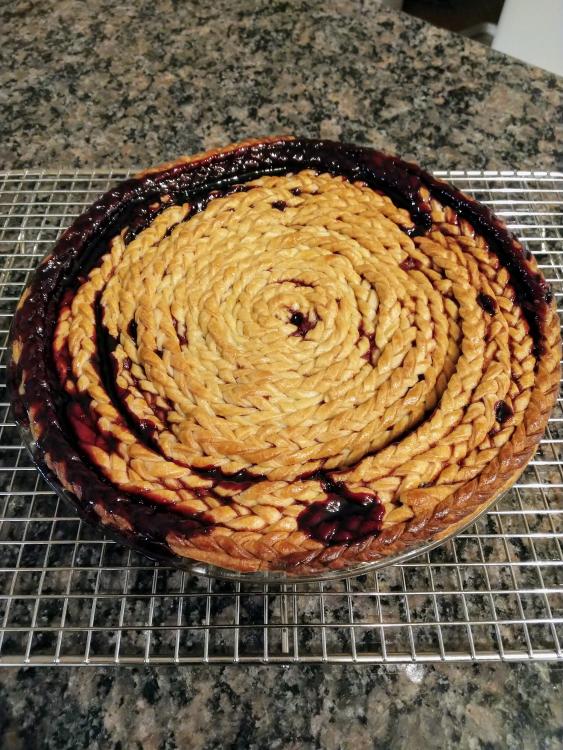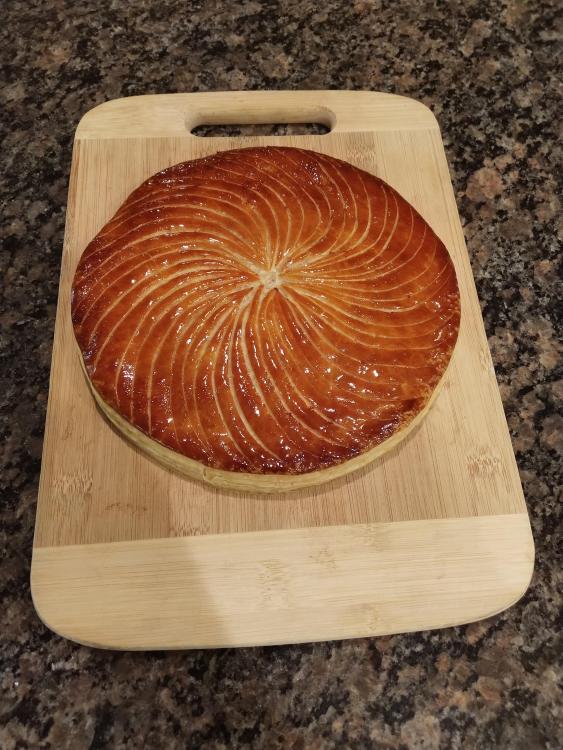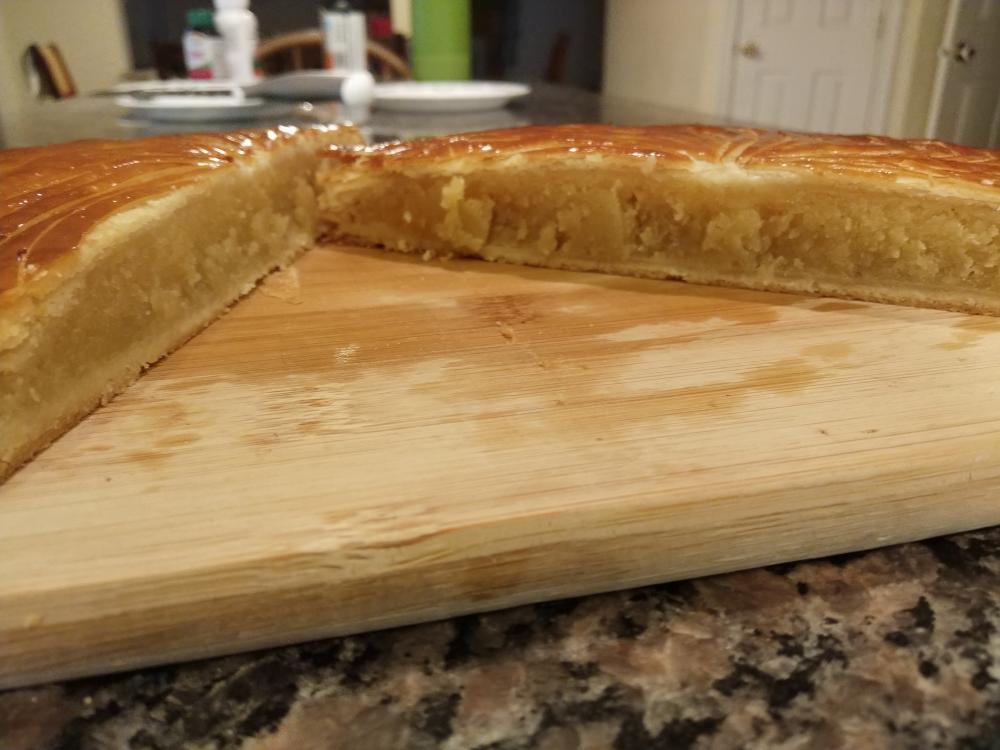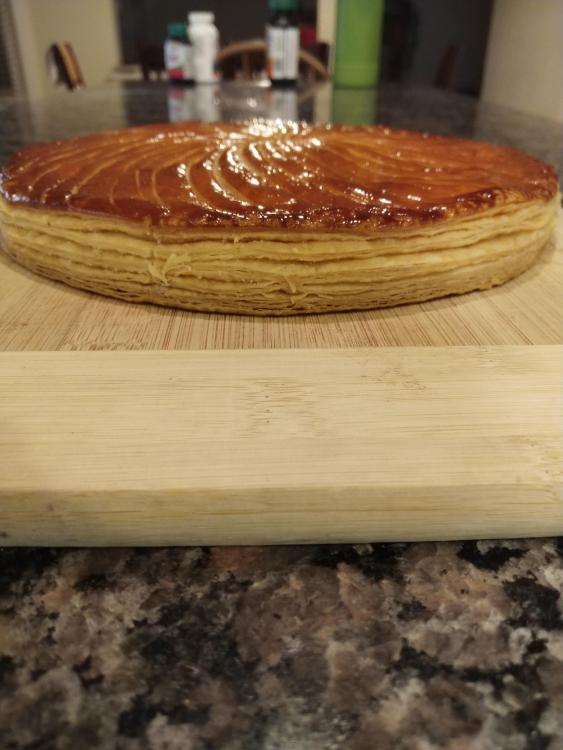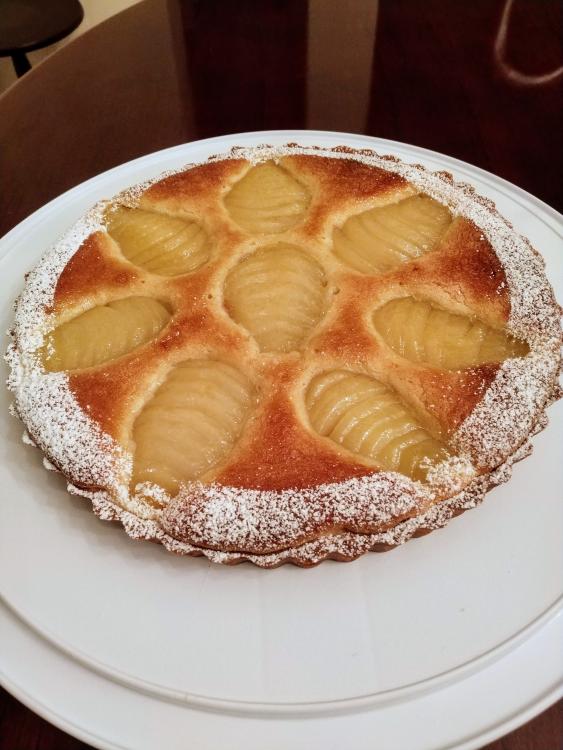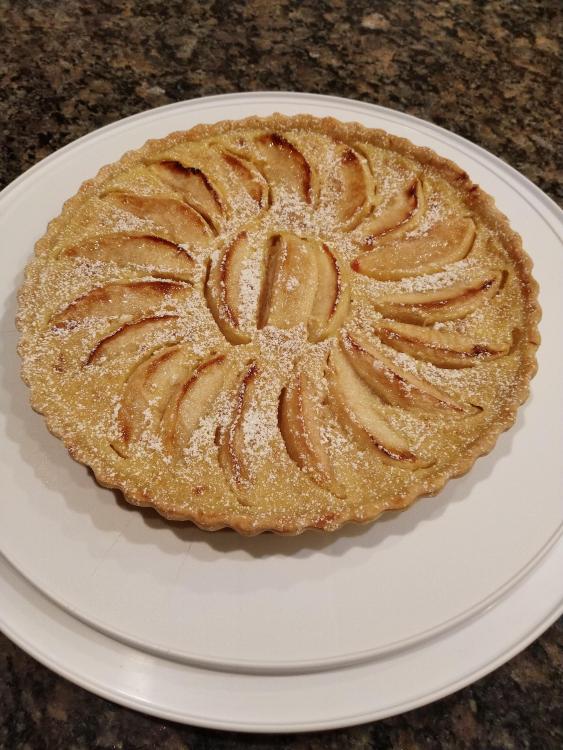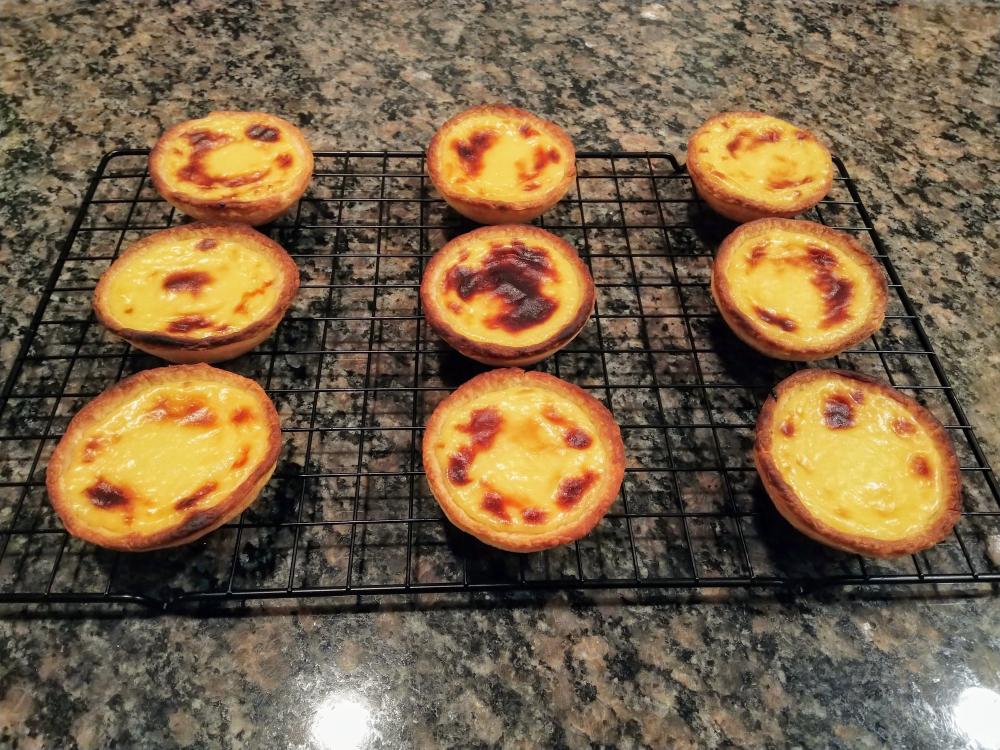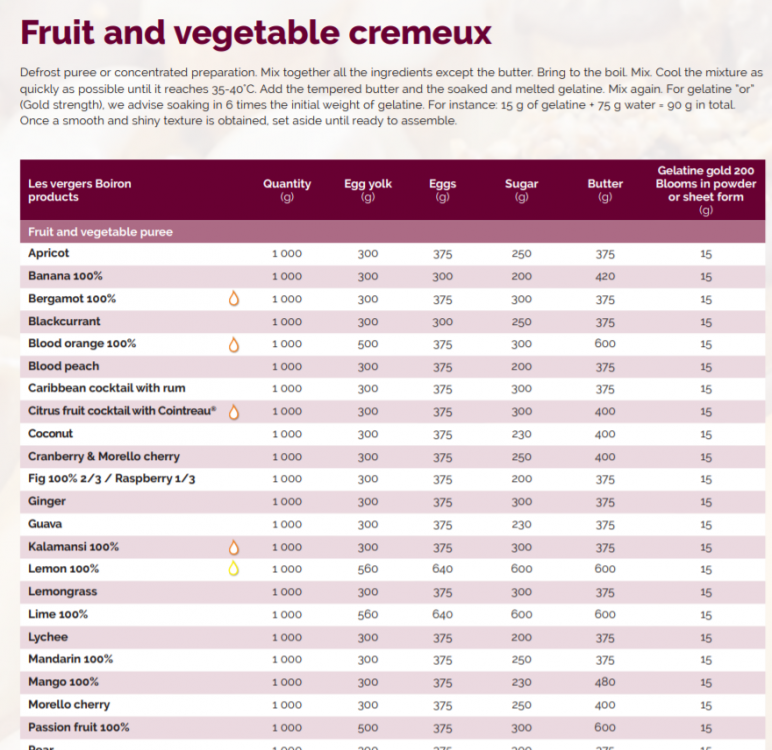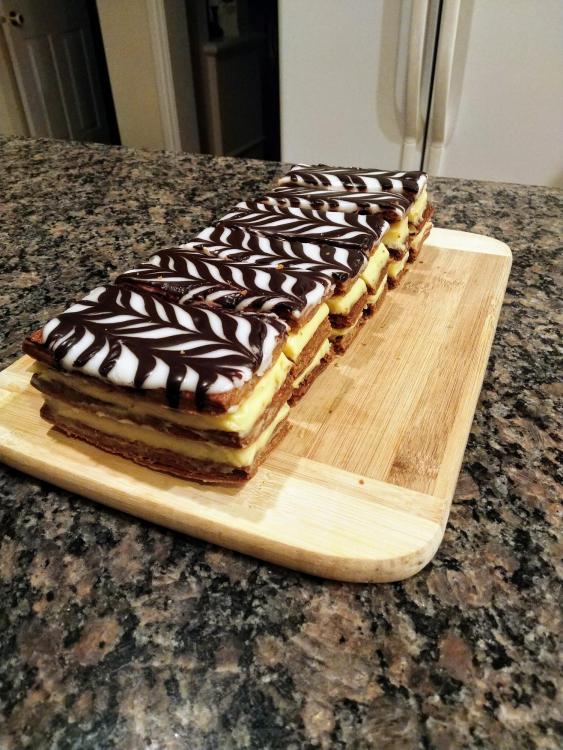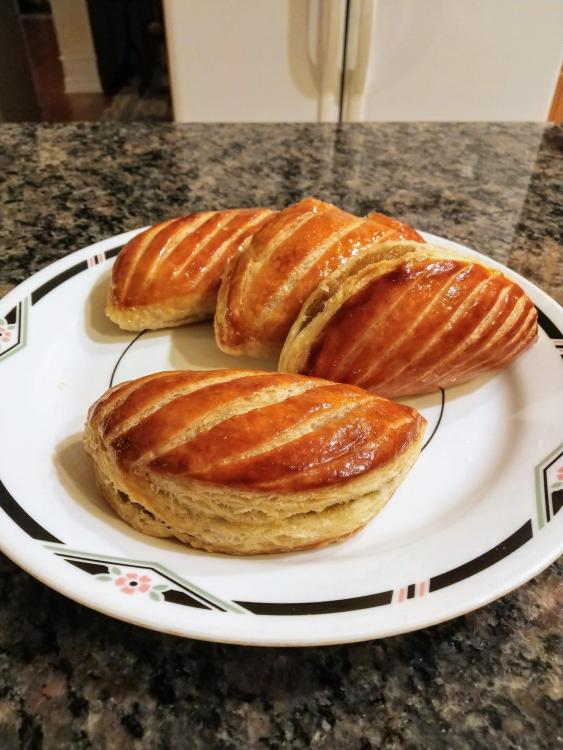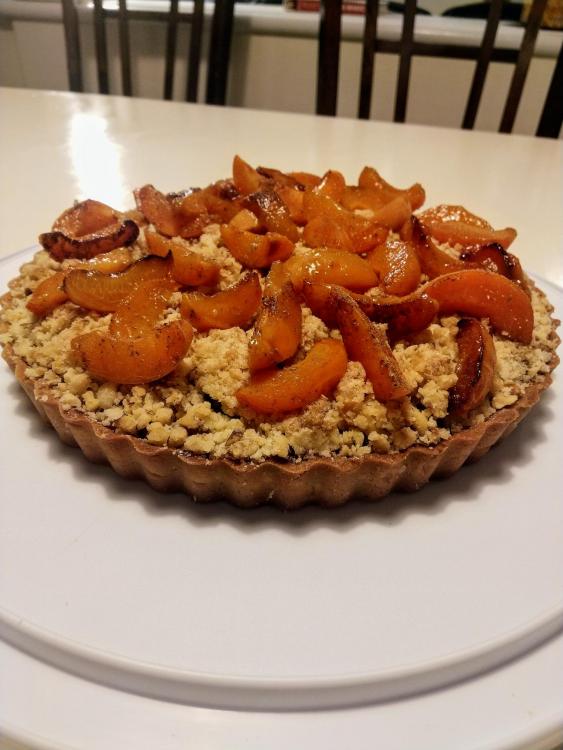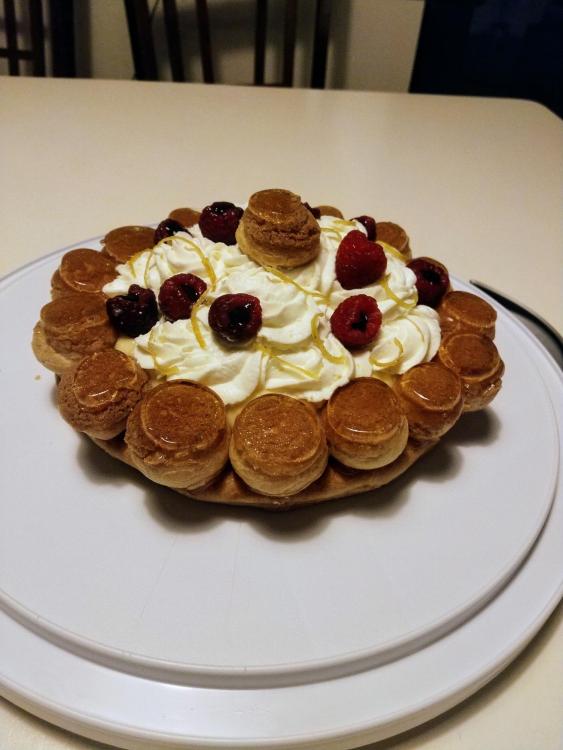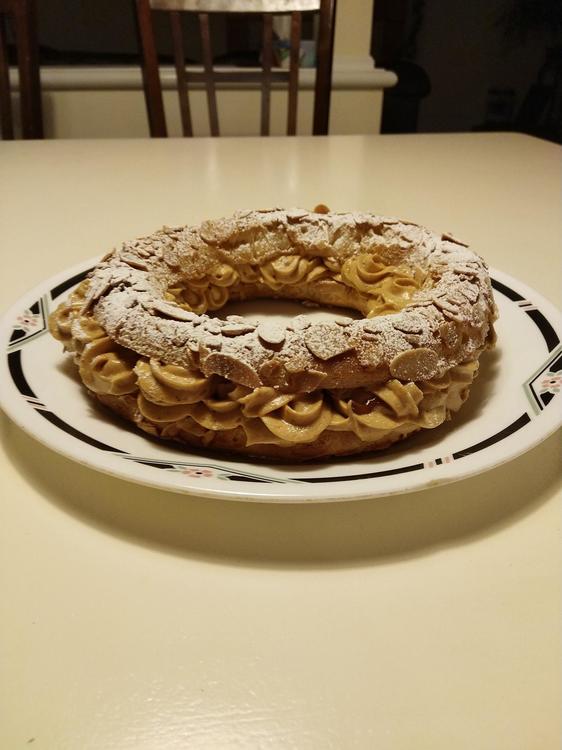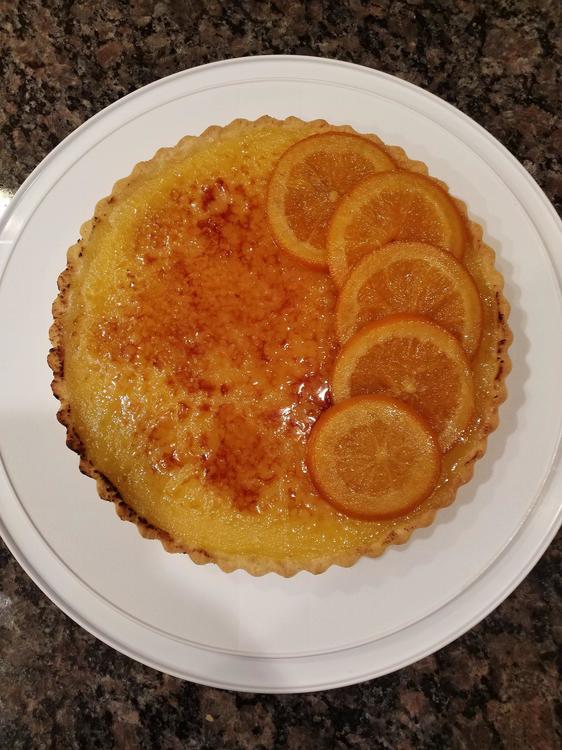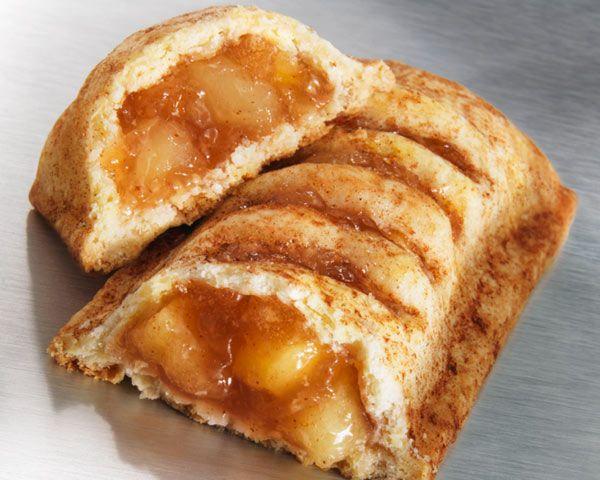
Cahoot
participating member-
Posts
59 -
Joined
-
Last visited
Content Type
Profiles
Forums
Store
Help Articles
Everything posted by Cahoot
-
Your Daily Sweets: What Are You Making and Baking? (2017 – )
Cahoot replied to a topic in Pastry & Baking
Braided it manually. Won't lie, just the braiding took a few hours haha. I originally actually just planned to do a lattice, but after I saw how many braids I'd prepared I figured I had enough to go for this design instead. -
Your Daily Sweets: What Are You Making and Baking? (2017 – )
Cahoot replied to a topic in Pastry & Baking
-
I'll have to look up the source again, but in Canada pretty much all granulated sugar is cane sugar. There's only one refinery in the country, located in Western Canada and owned by Rogers, that produces beet sugar. "To purchase Alberta-made Rogers sugar, look for a packaging stamp that starts with the number 22. This means the sugar is from Taber [the bet sugar plant]."
-
Ha while we're on the topic, one of my pet peeves with the Ferrandi book is how inconsistent they are with the formulas they use. For example, almond cream is used ten (10) times throughout the book (not counting almond-pistachio cream recipes where pistachio paste is added), and every single one uses a different ratio of ingredients, not even including different mixing methods too. The same is true for other base recipes like tart doughs, biscuits, pastry cream, etc. I get that the level 3 recipes are from famous pastry chefs, who may all have their own different formulas for almond cream, but it'd be less confusing if they standardized it to use the same base formulas for at least some of the recipes that use those components. But to digress, that amount of frangipane (230 g total) is used for a 20 cm spiral, so it really does seem I used way too much filling when I used 300 g almond cream for a 16 cm spiral.
-
That's also how I've understood it. It's made even more confusing by the fact that I usually see pithiviers made with savoury fillings instead of sweet. But I'm a stickler for pedantic terminology and try to follow the rules even if no one else actually cares!
-
I baked at 425°F (220°C) for 10 minutes, then 350°F (180°C) for 40 minutes. Something I should've mentioned before - there was a lot of butter that leaked out, which of course could've been a problem with that batch of puff pastry, but it's normally not an issue for me with puff pastry. For reference in case anyone cares, that picture was a 22 cm galette, with 300 g of almond cream in an 18 cm circle. Teo also advises using less filling so I'll do that. If you are interested in making one yourself, then I'll tell you it makes sense now why everyone makes galettes des rois (with frangipane filling) instead of Pithiviers (with almond cream filling) - straight almond cream is too cakey and dry to use as a filling by itself. Some additional fruit filling would definitely be necessary with a straight almond cream filling. @teonzo Thank you for your insights. For a 20 cm galette, I'll stick to 4 mm pastry thickness then, along with reducing the oven temperature and the amount of filling. About the frangipane terminology, I've always read that: Almond cream (crème d'amande) = almond meal + butter + sugar + eggs, where usually the almond meal, butter, and sugar are roughly equal by weight, and the eggs can be 50-100% the weight of the almond meal. Frangipane = 2 parts almond cream to 1 part pastry cream (by weight), e.g. 100 g almond cream combined with 50 g pastry cream. Although many recipes I've seen for frangipane use a smaller ratio of pastry cream. According to Wayne Gisslen's Professional Baking: "The term frangipane is given to a variety of almond-flavored fillings. In classical French pastry, it generally refers to a filling consisting of two parts (by weight) Almond Cream Filling (see recipe) mixed with one part Pastry Cream (p. 263). Today, however, many almond filling formulas, such as the ones on page 196, are referred to as frangipane. Almond paste is widely used in place of powdered almonds." I also know that in the UK and here in North America, frangipane is usually used to refer to almond cream, but don't know about other countries. However at this point I've really gone off on a tangent haha.
-
When I've made them, the rise has unfortunately been quite poor, especially as what I love about its aesthetics is how high it puffs up. Of course it can be due to issues with making the puff pastry itself (though I've practiced a bit and read up quite a lot, so I feel like I'm doing it mostly correctly), but I want to make sure my method for everything else is right. For reference, here are pictures of the most recent one I made, this time having tried inverse puff pastry for the first time. Filled with straight almond cream. Admittedly almond cream is of course a bit drier than frangipane, and the formula I was using was especially low on eggs/liquids, so changing that up could solve the dryness aspect I mentioned in my original post. Top: Height: Interior:
-
I have some really specific questions that might make me look super neurotic, but I've been trying to perfect the galette des rois/Pithiviers recently and so have been really scrutinizing the technique. I was hoping if there's anyone who can actually answer these questions, it'd be the pastry chefs here. In the interest of getting as high of a rise as possible, what thickness should the puff pastry be rolled to? I've seen 2-5mm thickness, and my intuition is that thicker layers rise more but the downside is that they take longer to cook through. Is that correct? Is there an optimal baking temperature? I know the general theory is that puff pastry is best started in a hot oven then have the temperature dropped to not burn it, but I've cross-referenced with almost a dozen recipes and their temperatures are all over the place. Some start at 390-425F (200-220C) then lower it (either immediately after putting it in the oven, or after ~10 minutes), while I've seen others bake at 340-390F (170-200C) for the entire time. About switching the filling between almond cream and frangipane (almond cream + pastry cream), can you just use the same amount of either? I've seen some sources say use about 67-70% the amount of frangipane as almond cream, e.g. 300g of almond cream can be replaced by around 200g of frangipane. However I'm not sure why you would need less frangipane than almond cream. If anything, since frangipane is just lightened almond cream, I figured an appropriate substitution ratio would be using more frangipane than the amount of almond cream. This also relates to my next question: Short of it leaking out, is there a downside of using more filling, e.g. does it negatively affect the rise? Some recipes seem to use a really conservative amount of filling, but I've found that sometimes the ratio of pastry:filling is high and makes it kinda dry. Ideally, I prefer the maximum amount of filling without compromising any other aspects of the pastry.
-
Your Daily Sweets: What Are You Making and Baking? (2017 – )
Cahoot replied to a topic in Pastry & Baking
Made a few tarts recently, just some more basic, classic recipes. Apple tart Tarte Bourdaloue Tarte normande Pastéis de nata On a related note: I've been looking into buying tart rings since I prefer the look of the clean, straight edges over the fluted edges. I have the option of buying tart rings with rolled edges, or just regular cake rings of the same height (2cm). Is there an advantage in using one over the other? -
I don't have a definitive answer but can throw in my experience. I've had oily cookies once using the Cook's Illustrated chocolate chip cookie recipe where part of the butter is browned and then added to the remaining butter, then sugars and eggs are whisked in. My suspicion was that the emulsion in the batter broke somewhere - a culprit could be when the hot browned butter is added to the unmelted butter (since melting butter naturally breaks the emulsion), but plenty of recipes use melted butter without resulting in oily cookies. However I've also made the recipe multiple times but only encountered the issue once, so I definitely suspect it was a mixing error rather than recipe/ingredient/oven fault.
-
I'm assuming this applies to the rolling for all laminated doughs? E.g. for making puff pastry, you don't want to refrigerate it overnight because then you'd run into the issue of the outer/inner layers of butter not being at the same consistency? Wondering since puff pastry generally requires more folds/turns than croissants so more time is needed for the laminating process. So most people at home make it a 2-day process.
-
Yeah Napoleons have 3 layers of puff pastry. I think the custard in the Aussie vanilla slice is also much more set than a normal pastry cream - apparently they're also nicknamed "snot blocks" there due to that consistency 😂
-
The method described instructs to whip all the ingredients for the ice cream base together, and just fold in any mix-ins at the end. Since I'm guessing I've too much water diluting the fat in my base, would the best option (if adding some more heavy cream isn't enough) to save the batch to try letting it freeze, then blending it in a food processor?
-
So apologies for a very amateur question, but I figured this is probably the best place to ask it. I'm making ice cream using the ice bath and hand mixer method detailed in this article, but my issue is that the mixture isn't whipping up at all. I used this cheesecake ice cream base recipe, replacing the strawberries and graham crackers with peaches. The peaches were prepared similarly to the method in Adam Ragusea's video, being finely chopped, macerated, and the resulting juice strained into the ice cream base. My guess is that there's too much water diluting the mixture, maybe from the added peach juice, preventing it from aerating, but I'm not sure. I've tried chilling the bowls in the freezer an extra couple hours to see if the salted ice bath wasn't cold enough, but that didn't solve the issue. I'll try adding more heavy cream next (plus sugar accordingly) and see if the issue's that the concentration of heavy cream is too low. What would you guys recommend doing?
-
I though acidity decreased the temperature at which the proteins in eggs denature and coagulate, not increased it? I found a table for fruit cremeux recipes from Les vergers Boiron, and it also calls for bringing all ingredients except the butter and gelatin to a boil. I found a possible explanation I found for why this is possible from Paula Figoni's How Baking Works: "Dairy proteins also likely interact with egg proteins, firming up the gel. Imagine egg custard made with water instead of milk. The custard would be very soft and barely set." So my theory is by replacing the dairy with fruit puree, removing the dairy proteins is enough to allow the mixture to boil without coagulating. For reference if anyone's interested, the table can be downloaded from their website (scroll down and select the "Download our basic preparations for pastry chefs" option), or I took a screenshot of part of the table: But some follow-up questions I had were: 1) How come some preparations (such as this one) call for bringing everything up to a boil together, instead of the traditional method of heating the liquid first and tempering the eggs? 2) Later in that document, they say "To fill eclairs, we recommend using the cremeux or two fillings: macaroon compote 1/3 – vanilla pastry cream 2/3." Why isn't pastry cream recommended? For cremeux, I can guess that its freezability makes it more flexible in commercial kitchens than pastry cream. A wild guess for recommending compote + vanilla pastry cream instead of a pastry cream made from puree is that you lose the richness from the milk, but they also include milk powder for some of the pastry cream recipes.
-
Your Daily Sweets: What Are You Making and Baking? (2017 – )
Cahoot replied to a topic in Pastry & Baking
Mille-feuilles. Fondant was too thick and edges could have been cleaner, but you live and learn! Apple turnovers, with an applesauce + sauteed diced apple filling for a variety of textures. Apricot rosemary tart. Rosemary almond cream, apricot marmalade, nut streusel, and seared apricots. -
The main difference with what happened to me was that the caramel separated during the cooling down period before combining it with the eggs, so the issue was really separate from the eggs. I didn't notice any curdling after adding it to the eggs. The pie itself still turned out great. I guess the separation after adding the butter probably didn't make a difference since it was expected to anyway (whether during the cooling down process or after adding to eggs), but I was still curious on how to prevent the issue from coming up in the future in case I make a similar caramel with lots of butter and no cream.
-
Manager note: This post, and the two immediately following it, have been split from this topic to maintain focus. This was a very interesting read. I recently made this pecan pie recipe, which involves making a caramel and then adding butter directly to it after reaching the desired colour. My problem was that the caramel sauce separated as it cooled down. From the Teo's explanation, is the likely culprit because there's a too low water-to-fat ratio (since it was just a caramel with no cream, there's actually almost no water left), which made creating the fat-in-water emulsion more difficult? If that's the case, then I wonder why the recipe is formulated that way, instead of adding some cream before the butter which is much more common from what I've seen. The author of the recipe, Stella Parks, actually has a caramel sauce recipe that uses only cream, no butter, and she specifically wrote about how the shock of adding butter to a 350°F/180°C caramel can easily break the emulsion. But sticking with the original pecan pie recipe, what would be the best way to prevent the caramel from separating in the future? I see people mention using an immersion blender in this thread, but the recipe just calls for gently stirring with a rubber spatula. The butter is also supposed to be cold before adding, and the video of the pie being made shows it as a whole stick. Is this to keep it from melting too quickly?
-
Your Daily Sweets: What Are You Making and Baking? (2017 – )
Cahoot replied to a topic in Pastry & Baking
First time making gâteau St. Honoré. Honey pastry cream and honey Chiboust, lemon Chantilly, fresh raspberries filled with raspberry jam, and candied lemon zest. Took me almost 6 hours just on the day of, not even counting prepping the puff pastry, craquelin, or pastry cream beforehand! -
Your Daily Sweets: What Are You Making and Baking? (2017 – )
Cahoot replied to a topic in Pastry & Baking
Nothing impressive compared to the stuff made by professionals here, but got to try my hand at making some classic basic pastries. Paris-Brest. Piping extra praliné between the creme mousseline and adding crushed reserved pralines really kicks up the praline flavour and adds nice texture. Orange brûlée tart with candied orange slices. Caramelized apple tart. Not the most photogenic, but absolutely one of the best tasting desserts I've ever had. -
Does anyone have experience using adjustable cake rings? I can get them on Amazon for around $20 (one example), which is incredibly cheap compared to fixed cake rings from my local restaurant supply store (starting at $17 for 6 inch diameter). As I would like to have eventually a few sizes from 6-8 inches for flexibility, I could save so much buying an adjustable ring, but I've concerns reading reviews about the ring not holding well, or rings not being completely level, causing liquids mixtures to flow out underneath. However, I also wouldn't even plan on tackling making entremets until much later, so it wouldn't be very economical for me to spend so much money on a fairly niche equipment.
-
So I did some further research into fast-food apple pies, and something interesting I found was that a "secret ingredient" McDonald's used to use in their hand pies was apple powder, essentially ground up freeze-dried apples. Stella Parks apparently actually used this idea in her BraveTart book for recreating the McDonald's pies. The powder is supposed to fulfill the function of a thickener, absorbing the liquids released, while also adding more apple flavour. This would be a super fun idea to play around with, but unfortunately the cost of getting freeze-dried apples in the quantities I need would be prohibitively high :(. Looking at other chains' ingredients lists for their apple pies, they seem to use a variety of starch- and gum-based thickeners, and HFCS is also common - obvious main purpose is sweetness, but maybe it also contributes to the jammy texture? I think using apple compote or jam is also a neat idea to get the texture I'm going for. All these ideas may be too much experimentation than feasible for me to do in my spare time right now, but it's fun to think about at least!
-
Thanks for letting me know, I completely missed it! It was a nice read with some interesting ideas, but I also wanted to have a more in-depth discussion on techniques for making the pie itself. I'd never heard of it before, but torta di mele looks very similar to Dutch apple pie (which I've also never had but is on my list of things to make), down to the shape, shortcrust pastry, raisins, and light use of spices. I also didn't know that the raisins absorb most of the liquid - speaks to my inexperience haha, but definitely an idea to consider using. I understand what you mean by it's a rustic pastry, since here in North America it's also one of those basic pies that people pass down recipes for generations, and over-complicating it or making it too fussy is probably against the spirit of "as American as apple pie". However, I thought it'd be a fun experiment to ways to solve common problems I see people having with it, and plus I haven't seen any recipe for the gooey-type of pie I'm going for outside of Kenji's. I'm not sure if they're common in Europe, but it's similar to the thick filling in pies here sold in supermarkets or even fast food places, such as the McDonald's hand pie: I'm sure people look down on that preference, but it's my guilty pleasure lol. About the pre-cooking of apples, couldn't you just cut the apples thicker to prevent them from overcooking? Additionally I guess it would depend on your personal preference on how you like the consistency of the apples, but maybe there's something I'm missing here too. The lemon juice was also something I was unsure about since some recipes include it while others don't, but my intuition is that a small amount can only help out.
-
Being one of my favourite desserts, but also having little experience making it myself, I'd like to start a discussion regarding the classic apple pie. In the past couple days, I've looked at way more apple pie recipes and discussions than any sane person should, and now I'd like to hear what you guys may have to say with your experiences. Specifically, I'd like to focus on three main topics or issues prevalent when making it: a soggy bottom, a gap between the filling and the top crust, and the type of thickener used. Preventing a soggy bottom There are of course tips like preheating the baking sheet in the oven before placing your pie pan on it, baking at a lower rack, and even blind baking the bottom crust for a short bit before placing the filling and top crust on. However, I feel like these are all bandaid fixes rather than addressing the core problem, which is a runny filling. A common method I've seen is to first macerate the apples, then either discard or cook down the accumulated juices, or cook the apples on the stovetop first for a bit until they've lot off some juices, then remove the apples and continue cooking the juices down. From what I understand, when macerating the apples, most of the "juice" that accumulates is just the sugar since it's hygroscopic, right? Then throwing them away would be a huge waste, and hence reducing the juice seems to be the best approach here. I've tried Stella Parks' apple pie recipe, which calls for macerating the apples and then filling the pie with the apples and the macerated juices without cooking them down, but the final outcome was much too soupy for me. Overall, reducing the juices seems to be the best method, but my question is, does it also address the next issue, which is: Preventing a gap from forming between the filling and the top crust This is caused by the apples further shrinking during baking, and a sub-symptom of this problem is mushy apples when the apples are overcooked. This is really my main inspiration for making this thread, after reading J. Kenji Lopez-Alt's article on how to solve this issue through stabilizing the pectin in the apples by keeping them at 160°F for 10 minutes: https://sweets.seriouseats.com/2011/10/the-food-labs-apple-pie-part-2-how-to-make-perfect-apple-pie-filling.html He gives four methods to do so: on the stovetop, in the microwave, in a sous-vide water bath, or by pouring boiling water over top. Does anyone have experience with any of these methods, and how much of a difference is there in the results compared to just cooking down the apples/juices on the stovetop to reduce juices, but not doing the full keeping-at-160°F-for-10-minutes thing? Kenji's recommended simplest method is the boiling water method, but my concern (and from reading reviews) is that it gives the apples a watered-down taste, even after ensuring that they're dried out. From reading the reviews of his recipe, it seems that the most people have great results regarding the structure of the pie, but some find the taste lacking. Some may consider this blasphemous, but my ideal apple pie is gooey, sweet, and strongly spiced, kind of like the McDonald's hand-pies, so I was wondering if there was a way to combine the solutions used for the first two problems. Of course, Kenji actually has a recipe for this exact kind of pie: https://www.seriouseats.com/2015/11/the-food-lab-extra-gooey-apple-pie.html, which does combine the methods previously discussed. He gives options to hold the apples at 160°F for 10 minutes using either the stovetop or sous-vide, then further cooks the apples on the stovetop to reduce the juices. However, I don't have a Dutch oven or a pot large enough to fit all the apples required to do it on the stovetop, nor a sous-vide machine, so this is where I have to find an alternative, and I'll need peoples' insights into whether my ideas may work or if I'm just talking nonsense. I see two other ways to accomplish what I want: a) provided I've a microwave-safe bowl large enough, combine the apples, sugar, and spices in the bowl, and use the microwave to accomplish the pectin-stabilization, then finish reducing the juices on the stovetop (potentially in batches if needed), or b) do the boiling water pour-over method first, then add the sugar and spices and reduce juices on the stovetop. However, the microwave method seems really tedious and difficult to maintain at 160°F for an entire 10 minutes, hence option (b) seems the simplest. Again, there are multiple ways I can approach this here. I could just take all the apples after they've been in the hot water, and cook them all on the stovetop for a bit like in the recipe, or an even simpler but more time-consuming way could be to macerate them further, then just take the juices and reduce them instead of cooking the apples themselves. For the more experienced cooks here, would this still accomplish the same thing, or do I need to actually cook the apple slices themselves on the stovetop? Type of thickener Finally, a common point of discussion from where there seems to be no consensus is the best type of thickener for pies. Everyone has cornstarch and flour in their pantry, but tapioca starch is also commonly available. I've seen some people say good things about ClearJel here and there, but overall it appears to be very uncommonly used. However for a gooey pie like what I'm going for, are the clearer results from tapioca starch or ClearJel even needed, or would cornstarch or flour do fine? Another factor is that since the filling would need to be quite thick, would using cornstarch/flour leave too much of a starchy taste or leave the filling too goopy? If you've made it this far I gotta commend you for enduring all my inane rambling, but I'm looking forward to hear additional insights into my thoughts and see if I can reproduce an apple pie that I'm happy with
-
Thank you for the detailed comments on each title! I guess I'll finish Professional Baking, then look towards The Professional Pastry Chef and/or French Patisserie. I also actually have RLB's Baking Basics, but of course I'll need to put Baking Bible on my radar for more involved recipes. And the Kaffeehaus suggestion looks wonderful - I'll admit most of my (very limited) knowledge of pastries so far is mainly just French patisserie, but I want to ensure I'm not ignoring the rest of Europe and that looks like exactly what I want. Your suggestions are much appreciated!


